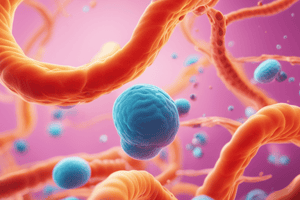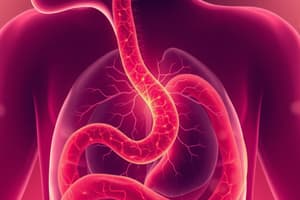Podcast
Questions and Answers
What is the primary causative organism associated with acute phlegmonous gastritis?
What is the primary causative organism associated with acute phlegmonous gastritis?
Which of the following is NOT an inhibitor of acid production?
Which of the following is NOT an inhibitor of acid production?
What is the least acid output time according to basal acid output (BAO)?
What is the least acid output time according to basal acid output (BAO)?
Which of the following clinical features is NOT associated with acute phlegmonous gastritis?
Which of the following clinical features is NOT associated with acute phlegmonous gastritis?
Signup and view all the answers
What does a BAO/MAO ratio greater than 0.6 suggest?
What does a BAO/MAO ratio greater than 0.6 suggest?
Signup and view all the answers
Which antibiotic is most commonly associated with changing gut flora leading to Pseudomembranous Enterocolitis?
Which antibiotic is most commonly associated with changing gut flora leading to Pseudomembranous Enterocolitis?
Signup and view all the answers
What is the primary organism responsible for Pseudomembranous Enterocolitis?
What is the primary organism responsible for Pseudomembranous Enterocolitis?
Signup and view all the answers
What is the incubation period for Pseudomembranous Enterocolitis?
What is the incubation period for Pseudomembranous Enterocolitis?
Signup and view all the answers
Which toxin produced by Clostridium difficile is considered the most potent?
Which toxin produced by Clostridium difficile is considered the most potent?
Signup and view all the answers
Which of the following antibiotics is associated with the highest risk of developing Pseudomembranous Enterocolitis?
Which of the following antibiotics is associated with the highest risk of developing Pseudomembranous Enterocolitis?
Signup and view all the answers
What is the first step after a positive test for H. pylori?
What is the first step after a positive test for H. pylori?
Signup and view all the answers
What should the initial action be if a patient tests negative for H. pylori?
What should the initial action be if a patient tests negative for H. pylori?
Signup and view all the answers
What is the next step if a urea breath test is positive after second-line treatment?
What is the next step if a urea breath test is positive after second-line treatment?
Signup and view all the answers
If a patient tests positive after third-line treatment, what is the recommended course of action?
If a patient tests positive after third-line treatment, what is the recommended course of action?
Signup and view all the answers
What should be avoided for at least a month after the first-line H. pylori treatment?
What should be avoided for at least a month after the first-line H. pylori treatment?
Signup and view all the answers
What is the main indication for performing an endoscopy in suspected peptic ulcer disease?
What is the main indication for performing an endoscopy in suspected peptic ulcer disease?
Signup and view all the answers
Which of the following statements is true regarding the stool antigen test for H. pylori?
Which of the following statements is true regarding the stool antigen test for H. pylori?
Signup and view all the answers
What is the first-line treatment regimen for H. pylori infection?
What is the first-line treatment regimen for H. pylori infection?
Signup and view all the answers
What is a positive result in the rapid urease test indicated by?
What is a positive result in the rapid urease test indicated by?
Signup and view all the answers
What should be done if H. pylori is confirmed present during an endoscopy?
What should be done if H. pylori is confirmed present during an endoscopy?
Signup and view all the answers
Which layer of the gastroduodenal mucosal defense is directly involved in the process of restitution?
Which layer of the gastroduodenal mucosal defense is directly involved in the process of restitution?
Signup and view all the answers
What is a primary damaging factor that affects the gastroduodenal mucosa?
What is a primary damaging factor that affects the gastroduodenal mucosa?
Signup and view all the answers
Which component of the Enteric Nervous System is primarily responsible for intestinal secretion?
Which component of the Enteric Nervous System is primarily responsible for intestinal secretion?
Signup and view all the answers
What role do prostaglandins play in the gastroduodenal mucosal defense?
What role do prostaglandins play in the gastroduodenal mucosal defense?
Signup and view all the answers
What is the effect of the sympathetic nervous system on gastrointestinal motility?
What is the effect of the sympathetic nervous system on gastrointestinal motility?
Signup and view all the answers
Which virulence factor of Helicobacter pylori is responsible for neutralizing gastric acid?
Which virulence factor of Helicobacter pylori is responsible for neutralizing gastric acid?
Signup and view all the answers
What is the primary form of gastritis associated with duodenal ulcers?
What is the primary form of gastritis associated with duodenal ulcers?
Signup and view all the answers
Which symptom is NOT typically associated with dyspepsia?
Which symptom is NOT typically associated with dyspepsia?
Signup and view all the answers
Which of the following is a criterion for considering endoscopy in patients with dyspepsia?
Which of the following is a criterion for considering endoscopy in patients with dyspepsia?
Signup and view all the answers
What is the most common presentation of non atrophic pan-gastritis?
What is the most common presentation of non atrophic pan-gastritis?
Signup and view all the answers
What is the main cytokine involved in the pathogenesis of gastrointestinal conditions?
What is the main cytokine involved in the pathogenesis of gastrointestinal conditions?
Signup and view all the answers
Which of the following is NOT a clinical feature associated with the conditions discussed?
Which of the following is NOT a clinical feature associated with the conditions discussed?
Signup and view all the answers
What is the primary treatment option for conditions related to the discussed pathogenesis?
What is the primary treatment option for conditions related to the discussed pathogenesis?
Signup and view all the answers
Which enzyme produced by Helicobacter pylori helps create an alkaline environment?
Which enzyme produced by Helicobacter pylori helps create an alkaline environment?
Signup and view all the answers
What percentage of the population in developing countries is estimated to have chronic superficial gastritis due to H. pylori colonization?
What percentage of the population in developing countries is estimated to have chronic superficial gastritis due to H. pylori colonization?
Signup and view all the answers
What is the first course of action in managing a patient with non-severe infectious diarrhoea and WBC < 15000?
What is the first course of action in managing a patient with non-severe infectious diarrhoea and WBC < 15000?
Signup and view all the answers
Which test confirms a diagnosis of Clostridium difficile infection when both glutamate dehydrogenase and enzyme immunosorbent assay are positive?
Which test confirms a diagnosis of Clostridium difficile infection when both glutamate dehydrogenase and enzyme immunosorbent assay are positive?
Signup and view all the answers
What complication is most commonly associated with infectious diarrhoea?
What complication is most commonly associated with infectious diarrhoea?
Signup and view all the answers
In which scenario is surgical consultation recommended during the management of infectious diarrhoea?
In which scenario is surgical consultation recommended during the management of infectious diarrhoea?
Signup and view all the answers
Which clinical feature is characteristic of infectious diarrhoea?
Which clinical feature is characteristic of infectious diarrhoea?
Signup and view all the answers
What type of glands are found in the body/corpus of the stomach?
What type of glands are found in the body/corpus of the stomach?
Signup and view all the answers
Which secretion is produced by the G cells located in the antrum of the stomach?
Which secretion is produced by the G cells located in the antrum of the stomach?
Signup and view all the answers
What is the primary role of the enterochromaffin-like cells (ECL) in the stomach?
What is the primary role of the enterochromaffin-like cells (ECL) in the stomach?
Signup and view all the answers
Where is the fundus of the stomach located?
Where is the fundus of the stomach located?
Signup and view all the answers
Which type of cells in the body/corpus of the stomach secrete hydrochloric acid?
Which type of cells in the body/corpus of the stomach secrete hydrochloric acid?
Signup and view all the answers
Which type of chronic gastritis is commonly associated with H. pylori?
Which type of chronic gastritis is commonly associated with H. pylori?
Signup and view all the answers
What is a complication of Type A chronic gastritis?
What is a complication of Type A chronic gastritis?
Signup and view all the answers
What is the primary cause of Eosinophilic gastritis?
What is the primary cause of Eosinophilic gastritis?
Signup and view all the answers
Which condition is characterized by large tortuous mucosal folds in the stomach?
Which condition is characterized by large tortuous mucosal folds in the stomach?
Signup and view all the answers
Which type of chronic gastritis has an increased risk of gastric malignancy?
Which type of chronic gastritis has an increased risk of gastric malignancy?
Signup and view all the answers
Study Notes
Co-operative Synergism in Acid Production
- ECL cells produce histamine, increasing cAMP levels.
- G-cells secrete gastrin, acting on CCKB receptors in parietal cells.
- Acetylcholine binds to m3 receptors, contributing to calcium influx.
- Gastrin releasing peptide (GRP) and bombesin stimulate increased gastrin production.
Inhibitors of Acid Production
- Cholecystokinin (CCK) decreases gastric acid output.
- Prostaglandins (PG) provide protective effects in the gastric mucosa.
- Somatostatin inhibits gastric acid secretion.
- Gastric Inhibitory Peptide (GIP) acts to reduce acid output.
Basal Acid Output (BAO)
- Maximal acid output (MAO) peaks around 6 PM.
- Lowest acid output occurs at 6 AM.
- A BAO/MAO ratio exceeding 0.6 can indicate gastrin-secreting tumors.
Gastritis
- Defined as histological inflammation of the gastric mucosa.
- Most common causes include NSAID use and infections.
- Diagnosis made through clinical assessment, endoscopy, and histology but lacks correlation with symptoms.
Acute Phlegmonous Gastritis
- Rare inflammation of the gastric wall, characterized by neutrophil infiltration.
- Leads to thickening of the gastric wall and gas formation.
- Common in immunocompromised individuals, often caused by Streptococci or E.coli.
- Symptoms include abdominal pain, vomiting, and fever; can lead to stomach wall necrosis.
Pseudomembranous Enterocolitis
- Caused by Clostridium difficile following antibiotic therapy.
- Associated antibiotics include fluoroquinolone, cephalosporins, clindamycin, amoxicillin, and ampicillin.
- Toxin A is an enterotoxin; toxin B is cytotoxic and the most potent.
- Typical incubation period is about 2 days.
Management of Helicobacter Pylori
- Testing for H.pylori indicated for peptic ulcer disease or new-onset dyspepsia.
- Negative tests indicate H.pylori is not the cause; positive tests prompt first-line treatment.
- First-line therapies include urea breath test and stool antigen test for eradication assessment.
- Persistent positivity after treatment may require endoscopy and culture for sensitivity testing.
- Third-line failures are referred to specialists, considering treatment necessity.
Investigations for Diagnosis Confirmation
- Endoscopy is indicated in cases of epigastric pain or symptoms suggestive of peptic ulcer disease.
- Rapid urease tests performed during endoscopy assist in confirming H.pylori presence.
- Stool antigen tests and urea breath tests confirm eradication post-treatment.
Treatment Modalities
- First-line treatment includes a 14-day regimen of Omeprazole and Clarithromycin.
- Second-line treatments utilize Omeprazole combined with bismuth, amoxicillin, and metronidazole.
- Fourth-line plans adjust based on local antibiotic resistance patterns.
Layers of Gastroduodenal Mucosal Defense
- Composed of pre-epithelial, epithelial, and sub-epithelial layers.
- Protective factors include COX-I derived prostaglandins; damaging factors include acid, NSAIDs, and H.pylori.
Structure of the Gastrointestinal Tract
- The mucosa consists of a mucosal gel coating, epithelial layer, lamina propria, and muscularis mucosa.
- The outer layer is the serosa.
Pacemaker Cells of the GI Tract
- Interstitial cells of Cajal generate the basal electric rhythm (BER) responsible for GI motility.
Enteric Nervous System (ENS)
- Comprises intrinsic innervation via Auerbach's plexus (motility) and Meissner's plexus (intestinal secretion).
- Extrinsic innervation includes sympathetic (decreases motility) and parasympathetic (increases motility) controls.
Diseases Caused by Helicobacter Pylori
- Responsible for 70-80% of duodenal ulcers and 50-60% of gastric ulcers.
- Virulence factors include flagella, urease, lipopolysaccharides, and exotoxins that harm gastric mucosa.
Forms of Gastritis
- Antral predominant gastritis associated with duodenal ulcers.
- Corpus predominant atrophic gastritis linked to gastric ulcers and increased risk for carcinoma.
Dyspepsia
- Most cases are functional (75%).
- Symptoms include post-prandial fullness, early satiety, and epigastric discomfort.
Management Considerations for Dyspepsia
- A week-long trial of proton pump inhibitors (PPIs) should be considered.
- Endoscopy warranted for patients over 50, or if symptoms like weight loss or family history of gastric carcinoma are present.
Hypertrophic Gastritis
- Also known as Menetrier's disease, characterized by significant mucosal folds and protein loss.
- Associated with CMV in children; more common in males aged 40-60 years.
Studying That Suits You
Use AI to generate personalized quizzes and flashcards to suit your learning preferences.
Description
Test your knowledge on the mechanisms of acid production and its inhibitors in gastroenterology. This quiz covers cooperative synergism between various hormones and their effects on gastric function. Learn about the roles of histamine, gastrin, acetylcholine, and more.




